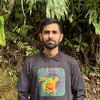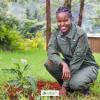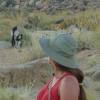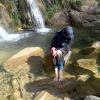Who We Are
Geospatial data and analysis is critical for conservation, from planning to implementation and measuring success. Every day, mapping and spatial analysis are aiding conservation decisions, protected areas designation, habitat management on reserves and monitoring of wildlife populations, to name but a few examples. The Geospatial group focuses on all aspects of this field, from field surveys to remote sensing and data development/analysis to GIS systems.
How to Get Started
Want to learn more about how remote sensing is used in conservation? Check out the first two episodes of this season of Tech Tutors, where our Tutors answer the questions How do I use open source remote sensing data to monitor fishing? and How do I access and visualise open source remote sensing data in Google Earth Engine? You can also check out our Virtual Meetup Archive for a range of panels that overlap with Geospatial topics, or take a look at our Earth Observation 101 lecture series from Dr. Cristian Rossi.
Our Purpose
The WILDLABS Geospatial Group is for conservation practitioners, geospatial analysts, and academics that want to:
- Share geospatial resources, best practices, data, and ideas;
- Network amongst geospatial and data practitioners;
- Create peer learning opportunities;
- Promote the use of free and open-source geospatial software; and
- Improve the use of GIS software and geospatial analyses in conservation management and research.
Group curators
3point.xyz
Over 35 years of experience in biodiversity conservation worldwide, largely focused on forests, rewilding and conservation technology. I run my own business assisting nonprofits and agencies in the conservation community



- 7 Resources
- 69 Discussions
- 12 Groups
- @ahmedjunaid
- | He/His
Zoologist, Ecologist, Herpetologist, Conservation Biologist





- 75 Resources
- 7 Discussions
- 16 Groups
Fauna & Flora
Remote Sensing Scientist, Conservation Technology & Nature Markets @ Fauna & Flora - WILDLABS Geospatial Group Co-Lead



- 42 Resources
- 49 Discussions
- 9 Groups
No showcases have been added to this group yet.
Sustainability Manager for CERES Tag LTD. An animal health company; animal monitoring, conservation, & anti-poaching/ rural crime. Wildlife, livestock, equine & companion. #CeresTrace #CeresWild #CeresRanch





- 2 Resources
- 20 Discussions
- 23 Groups
- @SimonsVictor
- | Marsha
I'm passionate about wildlife and animal management on development of conservation strategies for a long time monitoring
- 0 Resources
- 0 Discussions
- 8 Groups
- @serena.le
- | she/her
Conservation tech enthusiast
- 0 Resources
- 0 Discussions
- 24 Groups
- 0 Resources
- 0 Discussions
- 22 Groups
- @evan21
- | She/Her
University of St Andrews
Final Year Biology & Geography Undergraduate at the University of St Andrews
- 0 Resources
- 1 Discussions
- 7 Groups
- @lampros
- | He/Him
I am a Data and Remote Sensing Analyst specializing in programming (R, Python) at Monopteryx, contributor to open-source projects related to machine-, deep-learning, remote sensing and interested in Biodiversity
- 0 Resources
- 4 Discussions
- 10 Groups
Paul Millhouser GIS Consulting
USDA Agricultural Research Service
- 0 Resources
- 5 Discussions
- 4 Groups
Wetlands International
- 0 Resources
- 1 Discussions
- 1 Groups
- @cbreen
- | she/her
wildlife ecologist and snow scientist
- 0 Resources
- 0 Discussions
- 4 Groups
Software engineer working on natural resource management technology.
- 0 Resources
- 3 Discussions
- 6 Groups
Conservation Biologist


- 2 Resources
- 16 Discussions
- 6 Groups
- @rowan
- | they / them
Octophin Digital
Jack of all Trades. I've been a zoo keeper, a conservation geneticist and a web developer who specialises in conservation projects and orgs.


- 1 Resources
- 5 Discussions
- 15 Groups
As an early career conservationist with a keen interest in utilizing GIS for monitoring wildlife species and their habitats, the WiCT program has served as a pivotal platform for my professional development.
15 June 2024
Wildlife Drones was deployed by Zoos Victoria in a trial project tracking captive-bred Eastern Barred Bandicoots that were tagged and released into the wild
14 June 2024
How businesses can use the framework to develop nature strategies and prepare disclosures for regulations such as CSRD.
12 June 2024
Come and do the first research into responsible AI for biodiversity monitoring, developing ways to ensure these AIs are safe, unbiased and accountable.
11 June 2024
The International Climate initiative, opened a call for €20-25M projects. It will fund one project in this call with relevance for landscape restoration.
5 June 2024
WildLabs will soon launch a 'Funding and Finance' group. What would be your wish list for such a group? Would you be interested in co-managing or otherwise helping out?
5 June 2024
Human/wildlife conflict in a county in Kenya, worth the read.
27 May 2024
Do you have photos and videos of your conservation tech work? We want to include them in a conservation technology showcase video
17 May 2024
Article
Read in detail about how to use The Inventory, our new living directory of conservation technology tools, organisations, and R&D projects.
1 May 2024
Article
The Inventory is your one-stop shop for conservation technology tools, organisations, and R&D projects. Start contributing to it now!
1 May 2024
Technology to End the Sixth Mass Extinction. Salary: $132 - $160k; Location: Seattle WA; 7+ years of experience in hardware product development and manufacturing; View post for full job description
1 May 2024
September 2025
October 2025
event
November 2025
event
event
March 2026
September 2024
event
131 Products
Recently updated products
| Description | Activity | Replies | Groups | Updated |
|---|---|---|---|---|
| Hey MGatta, I'm working with adehabitatLt as well, i have a good paper on spatial referencing your data and changing your coordinates to UTM, if you want it (by C.J.... |
|
Geospatial | 8 years 8 months ago | |
| Hello all, I came across this website featuring free vector and raster datasets. Feel free to use it! |
|
Geospatial | 8 years 9 months ago | |
| Now the course is officially over, I wonder how people found it? Too difficult, too easy or just right? |
|
Geospatial | 8 years 10 months ago | |
| I'm not affiliated with Google or this event, but I thought it would be of interest to the community. I have previously attended and it... |
|
Geospatial | 9 years 2 months ago | |
| Things just got a whole lot easier for those of us at universities who train students to use drones as tools for conservation. Many... |
|
Geospatial | 9 years 3 months ago | |
| Another option is OruxMaps, free for android, not very intuitive but very powerful. But it's important to bear in mind that phone GPS accuracy can be lower than... |
|
Geospatial | 9 years 4 months ago | |
| ZSL is holding a remote sensing symposium on the 29th April, 2016: Space - the final frontier for biodiversity monitoring?... |
|
Geospatial | 9 years 4 months ago | |
| Hello all, This blog immediately make me think of our community and the possibilities for one of our members to provide a solution.... |
|
Geospatial | 9 years 5 months ago | |
| Thank you. I am doing pre reading and Information gathering, so I'll know what to expect and be prepared. Thank you for your kind answer Stephanie. |
|
Geospatial | 9 years 5 months ago | |
| Hello all - this paper looks highly relevant to this thread. "Satellite alerts track deforestation in real time: System uses... |
|
Geospatial | 9 years 6 months ago | |
| Advance Object-Based Classification of Delta Region Sindh. A project completed by COGE team. If you have any queries please contact :... |
|
Geospatial | 9 years 6 months ago | |
| Greetings all! I just received this invitation from Google. Feel free to distribute to your colleages. Applications due by March 15.... |
|
Geospatial | 9 years 6 months ago |
Introducing the Earth Engine Dataset Explorer Empowered by Google Gemini
29 October 2024 4:18am
Geospatial Analyst
28 October 2024 6:25pm
John Nelson Maps
GIS Education for Sustainable Development
17 October 2024 5:01pm
ArcGIS
Klas Karlsson
pyeogpr - Python based library that uses Earth Observation data to retrieve biophysical maps using Gaussian Process Regression
20 October 2024 6:13pm
Spatial Statistics for Data Science: Theory and Practice with R
20 October 2024 6:24am
GEO COP16 Pavillion
LEAPs and bounds
FOS Data Collection Tools
9 October 2024 4:29pm
11 October 2024 5:43pm
Hi Vance - where can we see the actual review of the tools - the attached "Field.pdf" only show very brief descriptions, and the link to the full chapter doesn't seem to point to a review, but rather a specific chapter on fieldwork in your book, without any reviews?
Thanks!
12 October 2024 2:05pm
MAAP #217: Carbon across the Amazon (part 2): Peak Carbon Areas
11 October 2024 9:27pm
Milos Makes Maps
200 Basemaps with a couple lines of code
4 October 2024 8:11am
4 October 2024 4:55pm
Sweet!! Thanks for this pro tip Vance!
7 October 2024 8:56am
You're welcome, Liz!
Want to learn QGIS!
26 December 2023 11:49pm
20 September 2024 3:59pm
GIS is an inevitable tech that's used in many field where wildlife science ain't an exception. I scrolled through the conversation and I hope there are plenty of resources here by now... So I would like to share few things relevant to the software and the importance in wildlife science.
Speaking about my usage of GIS in wildlife science, I started using it since during my bachelor's in wildlife science for identifying biodiversity rich zones in the Nilgiri hills of India, a decade back... Continued with an Master's degree in wildlife science, GIS was again useful for estimating the population of tigers in Mudumalai Tiger Reserve in India. Again for my MPhil thesis, I used occupancy models integrated with SDM for geckos to delineate the boundaries for gecko genera ,surprisingly there was this elevation which acted to separate one genus from another showing a altitudinal preference towards elevation (Biogeographically)
And so within this timeline I could see the evolution of the software and the usage trends in this field.
It still excites me , either to do something about creating a new shapefile for an unexplored remote region ,or predicting the range dynamics under species distribution modelling!
Thrills too,
Mapping for Species distribution models (SDM) using ecological knowledge, more often
- a taxonomist gets benefitted of identifying new species through the predictions.
- A conservation policy maker can identify places for species translocation in future (under climate change scenarios)
- Am evolutionary biologist can understand the biogeographic patterns of species from paleo climate to future via current climatic conditions
- Identify critical conservation blocks for immediate conservation of species of concern under anthropogenic pressures (For eg, Tigers or Critically endangered species)
Use the resources (online and via researchers ) try mapping more (maybe your study species of interest ) to study of interest (study area, biogeography, Sdm, LULC etc) using more of satellite data! It's really interesting this way!
Sure there are more avenues to use GIS BEING A Wildlife Biologist! Infact, inevitable:)
Best wishes
Abinesh A
5 October 2024 2:50am
Hello Sir,
Thank you so much for your reply and sharing this amazing resource, so far I have got some really great resources, so thank you for adding to those. I hope you can find some for your studies as well by going though the chat.
best of luck for you Masters.
5 October 2024 2:52am
Hello Sir,
Thank yo so much for sharing such an insightful message, as you said I have got some wonderful resources from other community members, so yes, just want to get better with QGIS now.
Thank you so much.
Advancing a Geographic Approach in Conservation Science
4 October 2024 10:34pm
15 October 2024 9:09pm
African Research Fellowship: 2024/2025
4 October 2024 10:24pm
ESA Training on EO for Forestry
4 October 2024 10:14pm
Biodiversity Data Engineer
Natural Lands Map V 1.0
4 September 2024 6:51pm
24 September 2024 8:32pm
Thanks for the feedback, Chelsea. Agree that it would be useful to understand who will be using it. I suppose other GIS/Remote Sensing specialists within NGOs. Perhaps someone in your team, @Helga_Kuechly ?
Also if anyone happens to have experience using the dataset it would be great to add this to the Inventory and also provide feedback to WRI through this form too.
30 September 2024 11:35pm
This link shows the difference between the new version and the old version of the Natural Lands Map for Cote d'Ivore and Ghana showing a lot less natural forest.
#côted #ghana | Land & Carbon Lab
🌍 Version 1 of our new, open-source Natural Lands Map combines local data with global data to improve land cover delineation! For example, here we can see how including local data enhances the accuracy of maps in #Côted’Ivoire and #Ghana, showing much less natural forest than what’s possible with global data alone. This tool, developed in collaboration with WWF, Systemiq Ltd. and Science Based Targets Network, provides critical insights for sustainable sourcing, addressing issues like deforestation and habitat loss. Check out our blog to learn more: https://bit.ly/3TEQa8q
2 October 2024 8:34am
That is great
Awesome GEE Community Catalog
1 October 2024 8:12pm












































23 October 2024 9:06am
Thank you. A workshop. Target is teachers for primary school learners. Thanks for the link!